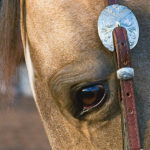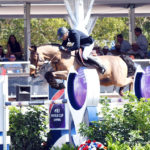Straighten your horse and ride it forward” was dressage master Gustav Steinbrecht’s admonition to equestrian scholars in the 19th century. Riders understood what he meant because they lived in an equestrian culture that spoke its own scholarly language with established meaning by tradition. However, in recent times, those not familiar with the intentions of Steinbrecht’s command have managed to misinterpret the urging of “forward” as a command to chase the horse into rushing, and then they have to pull on his mouth because he goes too fast. Remember, speed is also the enemy of impulsion.
When driving is misguided into demanding speed and agitated toward restraining hands, horses have nowhere to escape but upward with their croups. Their buttocks bounce with stilt-like, open-jointed hind legs—what we call “out behind” or “butt bouncing”—while heads are pulled behind the vertical with over-flexed necks. While these speedy chargers
often display a high, short and forced neck posture, let me assure you that they are the very documentations of horses on the forehand.
While this misplaced devotion to the “forward” part of the admonition has been championed, the “straighten your horse” part has been disastrously, continuously ignored. Yet straightening a horse is a precondition for the correct achievement of forward, the real meaning of which is locomotion with correctly articulating joints propelled by supple muscles. In other words, going forward means moving forward with strengthened and, therefore, engaged haunches.
Sadly, we often see a caricature of what was meant as guiding advise to those who lived in an equestrian culture of the past when horses were vastly important and horsemanship was an academically sound discipline. Too often we see tense horses running away with passenger riders balancing on their mouths. However, there are reasons for this misinterpretation and remedies for it.
Why Horses Run
We all know the horse is an animal of flight. He survived by early notice of lurking predators (startling instincts) and outrunning them (the flight instinct). If he were to be overtaken and contacted by the predator while in flight, he would fight by bucking, kicking or striking. Hence, when a startled horse takes flight, his rider should not act as his predator and try to pull him down, but rather accompany him in an unrestricted partnership in flight fully reverent to the horse’s survival instinct.
Had horses not been strong and swift, we would have nothing to ride today for their ancestors would have been eaten. Only those horses alert enough to be startled in time to run fast to escape their predators remained in the genetic pool. A horse can take off in full speed even from a halt. Therefore, the halt is also a “movement” because it is latent energy, potential for flight.
The instinct to flight was what attracted mankind to riding horses. All successful technologies in human history gained prestige by enhancing mankind’s speed and strength. The flight instinct of the horse is the foundation, the resource, of his useful energies. These energies are harnessed and harvested by the rider in his efforts to shape them into the athletically enhanced, groomed energy called impulsion.
The horse fulfilled the role of desirable “technology” in the service of mankind admirably for millennia. A fast-running horse was a treasure for traveling and military action. Desire for speed became one of the guiding principles in breeding horses. Indeed, it was racing that contributed considerably to the creation of the contemporary “super horse.” Without the horse’s forward instinct and energy for flight, we would have nothing to tame, shape and ride for our precisely controlled transportation. However, the horse’s ability to speed is just the starting point. It is the energy reserve and the raw material that by taming and training is groomed and altered into the wondrous variety of movements a correctly gymnasticized horse can offer his rider.
How to Avoid Running
Begin by developing an adhesive seat. The rider’s seat is a “transformer” whose role is to modify the energy emitting from the horse’s haunches. Remember, riding is controlled transportation, not just where we go and at what speed, but how effortlessly we arrive due to the schooled use of the haunches. The horse needs a relaxed, well-balanced tempo in order to take a longer stride and step with his hind legs past or into the footprints left by the front legs. Classical schooling like this allows the horse’s joints and muscles to develop strength and become capable of supporting the horse-and-rider’s
center of gravity.
Riders must learn to induce the correct posture of the horse (longitudinal flexion) and only then influence the level of engagement in his haunches. Horses not in a correct posture should not be driven, because they cannot engage to move and are forced to proceed under duress.
With gradually increasing strength and skills, the horse begins to shorten the distance between his hocks and the bridle. That distance could be likened to the string of a bow, which could be “tightened” or “loosened” by the rider. According to the engagement of the horse, the “bow string” will determine the amount of kinetic energy in the longitudinal flexion of the horse’s body. As bows do, so would the horse become resilient and swing, oscillate, articulate in his flexed (bowed) body. Such a horse can surrender the kinetic energies (latent in any bow) to his rider and allow a liquid transmission of these energies from haunches to the bridle. All this is, of course, controllable only by riders with adhesive seats that can transform the energy of the haunches for the horse to receive them in the bridle, where he can “read” the rider’s mind on the bit.
To achieve this, riders must slow the horse to a tempo that allows him to move by articulating the joints in his haunches evenly and unencumbered by the reins. Slow the horse until he is balanced, taken off his dwelling shoulders and gathered more weight toward his haunches. Slowing the horse until we reach the developmental efficiency of his haunches allows his locomotion to become efficient and supported by the harmonious and free articulation of his joints. In short, when the horse is enabled by balance to carry the rider correctly, then and only then should the rider adjust his movements for longer or shorter, faster or slower strides.
In riding, as in life, the means are different than the goals we aspire to reach. Great impulsion is developed gradually and systematically and is born from initial excessive slowing. This gives the horse the experience of how to increase the articulation of joints in order to remain in motion.
The balancing of the horse should be a perpetual riding task and must be appropriate to the athletic developmental level of the horse. The rider must energize the haunches (with leg aids) yet not permitting the horse to escape by speeding (with seat aids) in order to increase the articulation of his hocks toward the bridle. Forward and upward the horse should carry his rider with dancing steps lifting, rather than pushing and falling forward in a rush of kinetic energy.
Only a slow tempo can make the horse aware that he needs to carry his rider with impulsion and compel him to increase the articulation of his joints in order to strengthen and supple them. While the goal of collection and engagement must also result in the horse progressing in the same rhythm in highly variable strides on a continuum from maximum collection to maximum extension, the means to its mastery begins with slowing the tempo while increasing activity. The horse must experience, by radically slowing his tempo, the actual demand for locomotion by correct articulation of his joints. As a means to the end of great impulsion with impeccable engagement, initial slowing down is indispensable.
Slowing the tempo allows the rider to create impulsion, the indispensable foundation of engagement of the haunches. “Impulsion” refers to the horse’s ability to use all joints in his haunches with equal and unhindered articulation and thereby produce an efficient—not rapid—source of energy. Impulsion improves with the gradual increasing articulation of the joints. Impulsion, not running, is the source for strengthening and suppling the joints. Impulsion is based on the taming of the flight instinct and altering it into effortless efficiency.
Back to Steinbrecht’s Adage
The rider’s understanding of the goals of training and his knowledge of the means to attain them comes from Baroque ideology. This means that the horse’s natural potential can evolve into a monument of art only by the intelligent schooling of his rider. In other words, correct schooling makes the horse more beautiful. It all begins with “Straighten your horse and ride it forward.”
By reading this text and studying these photos, I hope you now understand the difference between a tense and agitated horse running out of balance in an unsuitable tempo (choppy, shuffling and unsuspended strides) and the horses pictured here, who correctly demonstrate the pinnacle of the training evolution—Steinbrecht’s adage fulfilled.
The well-trained horse is not frightened or attempting to flee. Relaxed and confident, he submits his energies to his rider’s disposal. That is the only acceptable interpretation of the idea of moving correctly forward, which celebrates the horse through the art of his rider.
Charles de Kunffy is a U.S. Equestrian Federation (USEF) “S” dressage judge (retired). A popular clinician around the world, he has taught judges and instructors on four continents and in the United Kingdom for 30 years. Born and raised in Hungary, he learned to ride from the classical masters at the Hungarian National Riding Academy. He carries on this tradition in his own teaching. Based in Palm Springs, California, he is the author of six books, including his new autobiography A Rider’s Survival from Tyranny (charlesdekunffy.com).
Jessica Jo “JJ” Tate is a U.S. Dressage Federation bronze, silver and gold medalist. She represented the United States at the 2007 FEI World Breeding Championships for Young Dressage Horses. She was a World Cup finalist and long-listed for the World Equestrian Games in 2006. She is on the USEF’s Developing Riders List. Tate and her husband, Richard Malmgren, are based at Hassler Dressage in Maryland (team-tatedressage.com).






